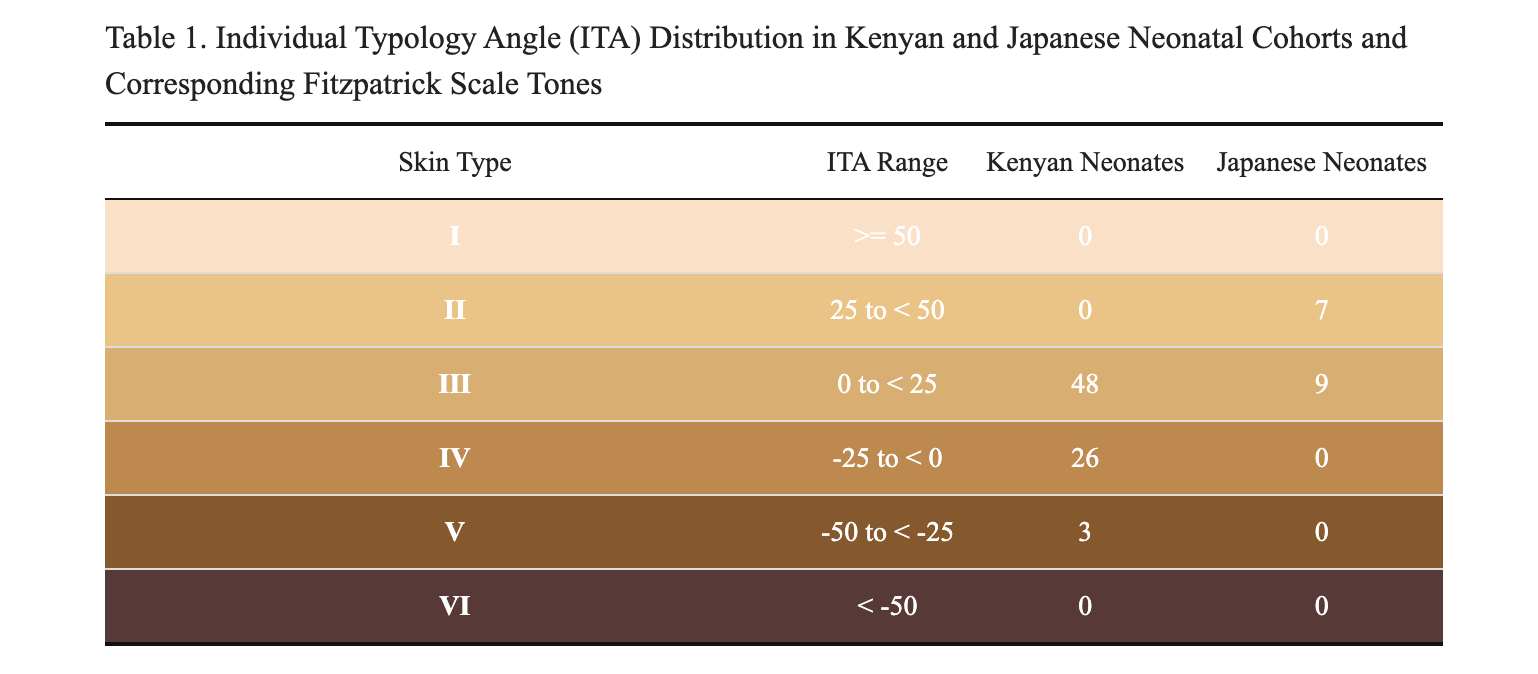Neonatal Quality Improvement 2
Session: Neonatal Quality Improvement 2
070 - Comparison of Kenyan and Japanese Newborn Skin Spectrophotometry -- Implications for Transcutaneous Diagnostic Devices
Friday, April 25, 2025
5:30pm - 7:45pm HST
Publication Number: 70.4054
Seth Bokser, UCSF Benioff Children's Hospital San Francisco, San Francisco, CA, United States; Priscillah J. Jepkorir Koech, Kenyatta University School of Medicine, Nairobi, Nairobi Area, Kenya; Anthony Wanyoro, Kenyatta University, Nairobi, Nairobi Area, Kenya; Ichiro Morioka, Nihon University School of Medicine, Itabashi, Tokyo, Japan; Imaizumi Takayuki, nihon univercity, itabashi-ku, Tokyo, Japan; Nobuhiko Nagano, Department of Pediatrics and Child Health, Nihon University School of Medicine, Itabashi-ku, Tokyo, Japan; Yuki Kimura, Konica Minolta, HIno, Tokyo, Japan; atsushi Miwa, Konica Minolta, Shinagawa, Tokyo, Japan

Seth Bokser, MD, MPH (he/him/his)
Clinical Professor
UCSF Benioff Children's Hospital San Francisco
San Francisco, California, United States
Presenting Author(s)
Background: Transcutaneous diagnostic devices are essential tools in neonatal healthcare. The American Academy of Pediatrics (AAP) endorses universal screening for hyperbilirubinemia in newborns, often conducted using a transcutaneous bilirubin meter. Similarly, the AAP and the U.S. Centers for Disease Control recommend pulse oximetry as universal screening for cyanotic congenital heart disease. It is crucial investigate how skin pigmentation may affect transcutaneous diagnostic tools in pediatrics and neonatal care.
Objective: We pooled data from African and Japanese newborns to characterize and compare skin tone using the individual typology angle (ITA) in the CIE L*a*b* color space, along with relative reflectance at clinically important wavelengths used by transcutaneous bilirubin meters and pulse oximeters.
Design/Methods: Data were gathered from two prospective cohort studies completed in 2023; both using the same non-invasive spectrophotometry technique. Investigators at Nihon University Itabashi Hospital (Tokyo, Japan) recruited 16 Japanese newborns, greater than 35 weeks estimated gestational age (GA). Investigators at Kiambu. Level 5 Regional Hospital (Kiambu, Kenya) recruited 80 newborns also greater than 35 weeks estimated GA. IRB approval and parental consent were obtained from Nihon University and Kenyatta University before study enrollment. Neonatal spectrophotometry data were pooled and compared using biostatistical techniques shown in results.
Results: Our results in Tables 1 and 2 demonstrate statistically significant differences (p < 0.001) in cutaneous reflectance between Japanese and Kenyan newborns at wavelengths commonly used by transcutaneous neonatal devices. Japanese newborns had a mean ITA of 26.35 (95% CI: 22.03 – 30.68) and were distributed within categories 2 and 3 of the Fitzpatrick skin tone scale. In contrast, Kenyan newborns had a mean ITA of 0.3 (95% CI: -31.16 - -20.94) and were distributed across categories 3 to 5. The mean ITA difference was -26.05 (95% CI: -31.06 to -20.94; p < 0.001). Table 3 demonstrates adequate power and normal distributions for our pooled analysis.
Conclusion(s): Skin reflectance in Japanese and Kenyan newborns varied significantly at clinically relevant wavelengths for bilirubin meters and pulse oximeters. Our study is limited by spectrophotometry at only one body site—the skin overlying the sternum. Future analyses will assess multiple body sites. This international pooled analysis provides valuable insights into the spectrophotometric basis for potential disparities in transcutaneous device accuracy related to skin pigmentation.
Table 3. Pooled Statistical Analysis Results
.png)
Table 2. Mean Spectrophotometry Values for ITA and Wavelength Reflectance
.png)
Individual Typology Angle (ITA) Distribution in Kenyan and Japanese Neonatal Cohorts and Corresponding Fitzpatrick Scale Tones

Table 3. Pooled Statistical Analysis Results
.png)
Table 2. Mean Spectrophotometry Values for ITA and Wavelength Reflectance
.png)
Individual Typology Angle (ITA) Distribution in Kenyan and Japanese Neonatal Cohorts and Corresponding Fitzpatrick Scale Tones


